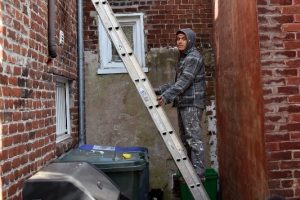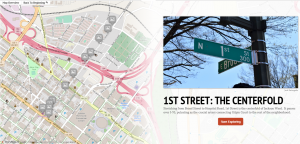
Pablo, a handyman, paints window trims on 1st Street. “You should be taking pictures everywhere,” he said. “It’s a beautiful city!”
by Jack DeAngelis
“I liked it before I moved here.” Marilyn Milio, former president of the Historic Jackson Ward Association, expressed two views of the I-95 highway that bifurcates Jackson Ward. It once acted as a connective corridor that efficiently moved through the city. But Milio realized how disruptive the freeway was after moving into a home located just one block away.
In 1946, the Virginia Highway Department proposed the construction of a high-speed alternative to U.S. Route 1 and U.S. Route 301. Most maps of the prospective corridor planned the highway to bisect Jackson Ward, a historically African-American neighborhood. In 1951, the city held a public hearing to debate the proposed highway. For over six hours, opponents of the project–led by representatives from churches located in Jackson Ward–raised their voices to protect their neighborhood.
Yet city officials were determined to have their highway. In 1954, a City Council bill that established the Richmond Petersburg Turnpike Authority was made law. Unlike city infrastructural planning groups before, this special committee was not restricted by public hearings. Instead, the Richmond Petersburg Turnpike Authority had unchallenged power to advance highway construction plans without the threat of referendums.
Four years later, the highway was opened, improving traffic flow around Richmond. But in building the infrastructure, Jackson Ward was cut in half with approximately 10% of the black community displaced. By 1958, about 1,900 families were evicted from their homes.
Today, the highway still stands as a racial and economic divider that severs Gilpin Court from the rest of Jackson Ward. A walk down 1st Street illustrates the disparity between the two sides of I-95. South and west of the highway is an up-and-coming district that highlights the excitement and artistic talent of the culturally vibrant Jackson Ward. The area north and east of the highway is dominated by public housing projects and abandoned buildings, suffering from years of neglect.
First Street is one of the only physical connections between the two sides of Jackson Ward, said Milio. The street passes over the highway, bridging the divide.
“I’m just glad to see that you’re walking the neighborhood,” she said. “We need more of that right now.”
Click the map below to walk 1st Street:

